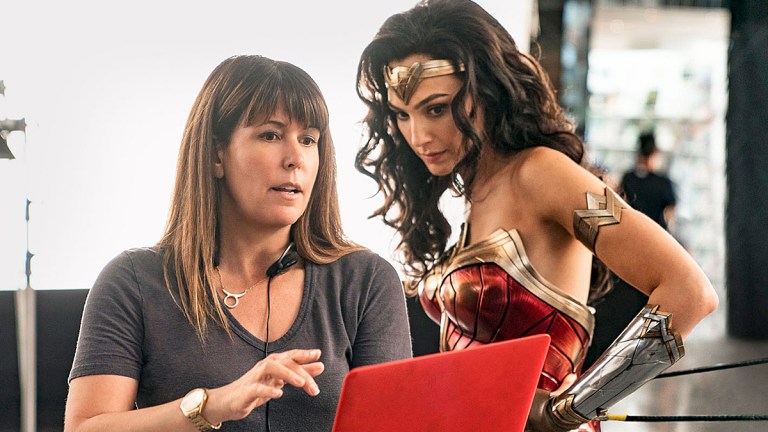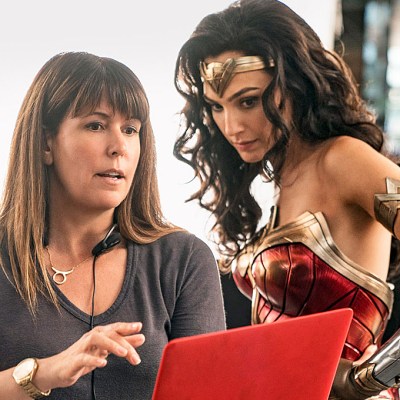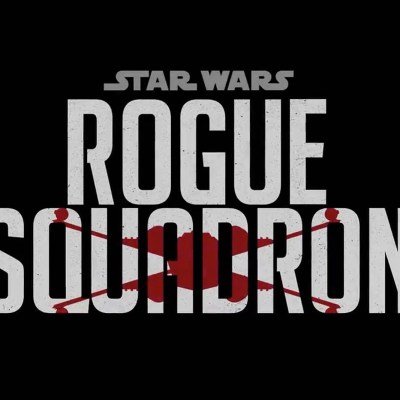How Patty Jenkins Steered the Wonder Woman 1984 Ship
We talked to Gal Gadot, Chris Pine, and Pedro Pascal about what it was like to work with Patty Jenkins on Wonder Woman 1984.

If you ask the cast of Wonder Woman 1984 pretty much any question about the film, they will find a way to gush about how much they love working with Patty Jenkins. Did Pedro Pascal bring any of his past characters into his new role as Max Lord? No, but it took a new level of vulnerability that Patty supported him through. Has Kristin Wiig always wanted to play a villain? Yes, and almost no one has asked her—except for Patty, apparently.
“[Patty is] like a Japanese sword,” says Wonder Woman 1984 star and producer Gal Gadot to Den of Geek and other outlets during a 2018 set visit. “No, really. It’s the same wonderful creative rule of hard smarts, see the bigger picture and the macro and the micro and everything. She has all the same qualities but now everything is quicker. She’s been there, she knows how it works. She has the same clues that worked with us in the previous one, and it’s just like this very smooth process.”
“Once Patty lands on an idea, it seems like it’s fully formed and she knows everything about it,” adds Chris Pine. “Since I’ve met her — she pitched me the first story — I’ve never met someone more self assured and more knowing about what she wants, how she’s going to do it, why she’s doing it. She is a machine. She is just a glorious machine to behold. A samurai sword is a good allegory.”
Even though Jenkins was not signed on to direct a sequel when she was making Wonder Woman, she still discussed prospective narrative plans with Gadot and Pine, starting about halfway through production.
“We were fantasizing about the next one if the first one would succeed,” recalls Gadot. “Then, we already started to talk about the story of this one. With Patty, it’s just a different work process. She’s very, she’s engaged. She’s very much engaging with all of us. And we all have a lot of say, into our character. Of course, the big broad vision is Patty’s. But she gives a lot of liberties and we do what we believe is right for the character. So I’m very, very lucky to work with her again.”
Jenkins wanted to do a second film in the franchise so that she could tell a Wonder Woman story past the origin tale of the character.
“She’s only Wonder Woman in the last scene of the [first] movie,” says Jenkins during a recent Wonder Woman 1984 press conference. “So I found myself really craving doing a movie about Wonder Woman, now full-blown Wonder Woman. And then I started reflecting on what I felt was going on in our world and what Wonder Woman would want to say to the world. And the story came out of that.”
Unlike the first film, Jenkins wrote the screenplay for WW84, along with Dave Callaham and Geoff Johns, the latter of whom also worked on the story with Jenkins. She ultimately found her way in with a compelling question.
“The last one was [Wonder Woman’s] discovery of humanity. Now, how does she live within humanity? And by the way, she’s not perfect either. So her own struggles and journey to do the right thing, which is so universal to all of us. Being a hero is not an easy thing, it’s actually a super difficult thing. So that I was really interested in too, of like, what does it feel like?”
Many critics who have screened the film already have commented on the broader themes, and how WW84 aligns so well with 2020. It’s impressive, considering how long ago it was written. Says Jenkins: “I found myself saying there was something about what the world wants to talk about right now, and she happens to have this lasso of truth, and truth ends up figuring in very large.”
And while Wonder Woman does exist within the larger DCEU, Jenkins and producer Chuck Roven have been clear that this is a standalone film. And while there might be some easter eggs, Jenkins said she and Geoff Johns were both really excited to tell this exact story.
“I’m not a huge fan of like doing chapter two of a seven chapter story. That’s just not my jam. I feel like that may happen in the way background, but every movie in my opinion that I want to make should be its own great movie,” Jenkins said on set. “So I have my own ideas about what her overreaching arc is, of the whole thing, but it’s the story first.”
No offense intended towards Superman, but do you feel like after this success of the first movie that Wonder Woman has become the new core of the DC universe now?
Fans and casual viewers might be excused for wondering if Diana Prince hasn’t eclipsed Clark Kent, in the DCEU if nowhere else. Certainly, a strategic advantage of both films taking place pre-2017 is that Jenkins and Gadot get to play with a pre-Justice League world.
Jenkins says, “I think that she planted her foot strong in the world. I mean I think that she’s a very strong core right now, and I think that there are lots of other great things that had been planted before and will be planted after. But I do I feel like she sort of landed and set her place in this world, and hopefully things are influenced by each other when they work in that way.”
In order to bring this new story to life, Jenkins wrote and directed a script for a much more complex film, logistically. Producer Charles Roven likewise glowed about Jenkins, calling her amazing to work with and sharing insight into the reality behind the scenes of a massive film like WW84.
“We expanded the global footprint of the places where we shot,” Roven said. “We shot in Virginia. Then we went to the UK and we also, after that, we went to Spain and then we went to the Canary Islands. So our global footprint really expanded significantly. And of course that makes it very, very complicated.”
Much will be made of Jenkins’s hiring of Cirque de Soleil performers and her decision to rely as much as possible on practical effects, and rightly so. The Amazons look powerful and natural because they’re really running, jumping, riding, and flipping through the air – the CGI is used to augment their natural abilities. In the case of Lily Apsell, who plays young Diana, she trained to run an obstacle course. CGI was used to add more dangerous elements that she doesn’t directly interact with that add to the suspense of the scene and maintained the actor’s safety.
As Pine put it, “That’s less about the hugeness of special effects, rather than making the special effects work for the realism of the film.”
For Jenkins, it’s important to carry the realism over to the characters too, especially villains. Without spoiling anything, there’s no moustache twirling in WW84. Pedro Pascal’s Max Lord and Kristin Wiig’s Barbara Minerva are on the more complicated end of the spectrum.
As Gadot puts it, “When I first read the script, I told Patty, ‘Wow, I like I like them as much as I like Diana and Steve.’ … I’m so tired of the obvious villain, the German soldier that you know from the get-go, okay he’s the bad guy — they’re like real people. Just like you, and you, and me. We can see ourselves in them. And they’re not bad people per se. But they just didn’t make the right choice at the right time. And I find it so interesting and so appealing, and I actually care about them.”
While the script certainly helps, so much of that comes from the performances of Kristin Wiig and Pedro Pascal.
Pascal is quick to credit Jenkins: “I call it the Patty Jenkins experience. You can’t get away with something that is the typical. It has to be a complete and have all the risks, and all of the danger, and ultimately the humanity, no matter how dark of a character it is to make the experience as honest as possible.”
“I wasn’t surprised because of all of her films that I’ve seen before and the performances that are in these movies. But I definitely didn’t know if I would be able to get there and I owe it to my director. I completely owe it to my director, if it worked.”
Reader, it worked.
He’s certainly not alone in his sentiment.
Kristin Wiig shared, “The wardrobe and the costumes and all of that definitely helped, and again, like Pedro was saying, working with Patty and trying to figure out who she is with every stage. But I’ve never done anything like this before.”
“It was very scary because I could visualize what I didn’t want it to be more than what I did want it to be. But I felt very taken care of and it was an amazing, scary, but fun experience for me,” Wiig said. “I was really shocked and happy and of course felt extra pressure when [I] signed on and when I was talking to Patty about it. But yeah, and I’m superhero geek. I see all the movies, I’m at the theater, I’ve seen all of them. I was obsessed with the first one. So to know that I was going to be in it, and that I got a chance to be a villain, and that Patty believed that I could do it, it was an amazing life experience for me.
It’s not unusual for stars to applaud their director on a press tour, but Patty Jenkins’s cast takes just about every opportunity to do so (though Pascal gives a lot of compliments in general, to everyone.) Having seen the final product, Jenkins backs up her good process with a good movie. In an industry that is so unequal when it comes to gender representation and opportunity both in front of and in particular behind the camera, it’s gratifying to see, especially considering that Warner Brother executives were so slow to secure Jenkins for the sequel. Not only was Jenkins not locked into directing a possible sequel in her initial contract, but subsequent contract negotiations took longer than expected as Jenkins fought to be paid the same as any male director would expect to receive after such a box office success.
But, for the cast, it’s not just about making a good movie; it’s about having a good and competent boss, and a safe and supportive workplace (not that the two aren’t usually related). That, among other things, seems to be, as Pascal called it, “The Patty Jenkins experience.”
“There’s something about working with a director that is completely there with you,” says Gadot. “For you, behind you, beside you, and to guide you. That gives us the freedom to really let go and take all the risks that one can be very frightened to take if you don’t have such a partner.”

